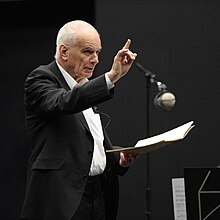Symphony No. 1 (Davies)
| Symphony No. 1 | |
|---|---|
| by Peter Maxwell Davies | |

The composer in 2012
|
|
| Composed | 1973–1976 |
| Dedication | William Glock |
| Recorded | August 1978 |
| Movements | 4 |
| Premiere | |
| Date | 2 February 1978 |
| Location | Royal Festival Hall, London |
| Conductor | Simon Rattle |
| Performers | Philharmonia Orchestra |
The Symphony No. 1 by Peter Maxwell Davies was composed between 1973 and 1976, and is dedicated to Sir William Glock, "as a mark of friendship and of appreciation of his work for contemporary music in his years as music controller at the B.B.C." (Davies 1978, 5). It was commissioned by the Philharmonia Orchestra, which gave the premiere of the symphony at the Royal Festival Hall, London, on 2 February 1978, with Simon Rattle conducting.
In his First Symphony, Davies addresses both the Beethoven model of the symphony and Sibelius's reinterpretation of it (Pruslin 1978, 7). Davies began work on what would become his First Symphony in 1973: a commission by the Philharmonia Orchestra intended to be performed the next year, resulting in a single-movement work of moderate length, provisionally titled Black Pentecost. However, the composer withdrew this score before it could be performed, feeling that it was not complete and needed to extend beyond the already-finished movement. In order to increase his understanding of large-scale orchestral composition, Davies analysed a number of other composers' works, and cites Sibelius's Fifth Symphony, the opening of Schumann's Second Symphony, and the first movement, "Don", from Pierre Boulez's Pli selon pli as precedents for specific moments of the composition. As the work evolved, Davies came to the conviction that it "could mark the possibility of a beginning of an orchestral competence", and so decided to designate it a Symphony. The pitches, note values, and longer time-spans are shaped and transformed by magic squares. Several plainsongs occur, and are transformed from one into another. The overall tonal centre is F, with a "modal dominant" of D♭ (Davies 1978, 2–3).
...
Wikipedia
